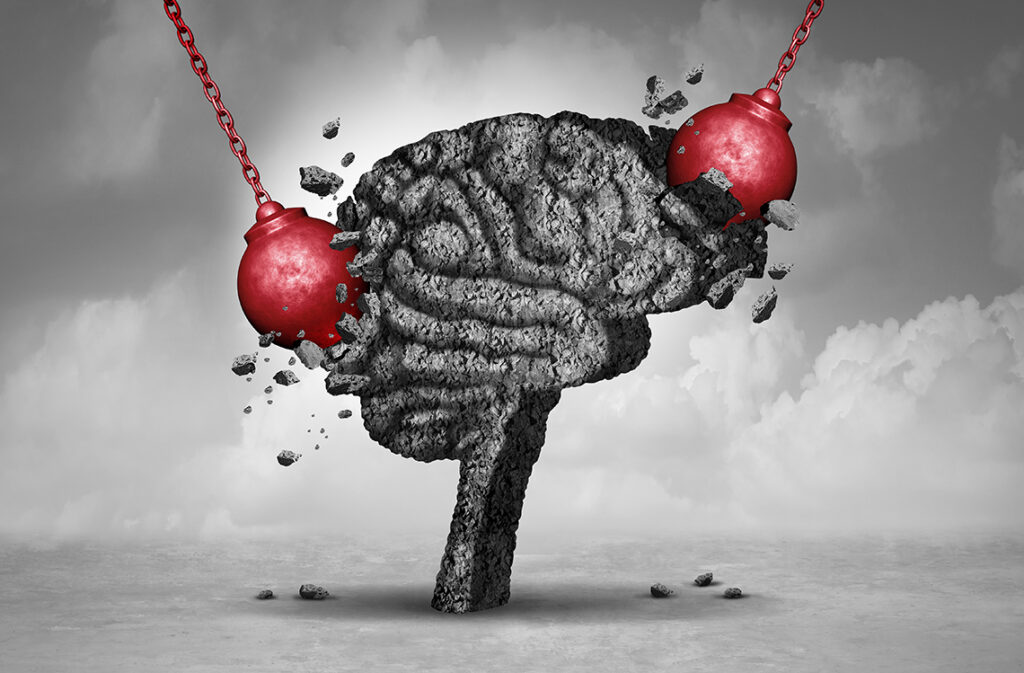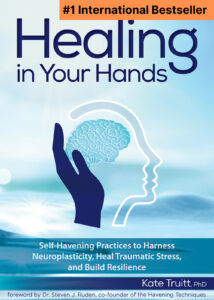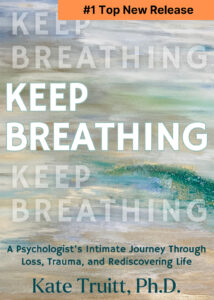Related Resources
For PTSD and CPTSD
What's the Difference Between PTSD and C-PTSD?
In this psychoeducational video, Dr. Kate Truitt explains the difference between Post-Traumatic Stress Disorder (PTSD) and Complex Post-Traumatic Stress Disorder (C-PTSD). The symptoms of CPTSD include those of PTSD—agitation, hyperarousal, anxiety, irritability, and intrusive memories—but with additional layers of complexity, such as feeling unsafe in our relationships, emotional dysregulation, and a disconnect with our sense of self. The good news is that healing is possible. By understanding how our brain and body respond to trauma, we can begin the journey toward recovery and self-compassion.
Understanding Trauma Survival Responses: Dissociation
In this psychoeducation video, Dr. Kate Truitt introduces us to the trauma survival response dissociation. Dr. Kate clarifies that in this video, dissociation refers to how our mind and body use dissociation to survive a traumatic encoding and how it might continue to show up in our life. Dr. Kate reminds us that healing is possible. The best way to do this is by getting our amygdala back online with ice cubes, sour candies, biting a lemon, or dunking our head in cold water. Then, once we feel more present, we can apply CPR for the Amygdala.
An Introduction to the Havening Touch
Dr. Kate Truitt introduces us to the havening touch in this psychoeducational video. She begins by explaining that havening touch can actually shift the way our brain is functioning in the moment. We have the ability to actually shift the electrochemical experience of our brain and thus the way our brain is interacting in a given moment. Havening touch decreases the presence of cortisol and norepinephrine, which contribute to anxiety and stress in our brain, while increasing oxytocin, which helps us to feel safe and connected in the world.
Understanding PTSD and Complex PTSD: A Path to Healing
By Dr. Kate Truitt
When it comes to trauma, we often hear about PTSD, or post-traumatic stress disorder. However, there’s an increasingly important conversation happening around complex PTSD, or CPTSD. While the World Health Organization has recognized CPTSD as a distinct diagnosis, the American Psychiatric Association’s Diagnostic and Statistical Manual (DSM) has yet to do so. This oversight is unfortunate, as complex PTSD, closely aligned with developmental trauma, has unique neurobiological markers and behavioral symptoms that set it apart from traditional PTSD.
So, what differentiates PTSD from CPTSD or developmental trauma? Let’s break it down.
The Nature of PTSD

PTSD typically arises from a single, acute traumatic event. This could be a serious accident, a natural disaster, or a violent attack—any event where the individual feels an overwhelming sense of danger and helplessness. Our brains, in their quest to protect us, record these events vividly, ensuring we remember them to avoid similar dangers in the future.
In PTSD, the symptoms include:
- Agitation and hyperarousal: The body remains on high alert, ready to respond to perceived threats.
- Anxiety or irritability: This constant state of vigilance can lead to heightened anxiety and irritability.
- Intrusive thoughts and memories: Flashbacks or intrusive memories of the traumatic event can disrupt daily life.
- Sleep disturbances: Nightmares and difficulty sleeping are common, further exacerbating the condition.
- Heightened reactivity to trauma triggers: Everyday experiences that remind the individual of the traumatic event can cause a reaction as if the trauma is happening again.
In this short clip, I talk about the uncommon symptoms of PTSD which includes:
- Executive functioning difficulties
- Dissociation
- Depression
- Substance use disorder
- Loss of interest in things
- Self-isolating
The Complexities of CPTSD

Complex PTSD, on the other hand, often results from prolonged, repeated trauma, usually occurring during childhood. However, it can also develop from ongoing traumatic experiences in adulthood, such as war, chronic grief, or intimate partner violence. CPTSD encompasses all the symptoms of PTSD but includes additional layers of complexity due to the chronic nature of the trauma.
In CPTSD, individuals often experience:
- Disrupted attachment and relationship issues: A profound lack of safety and trust in relationships is common. This stems from repeated breaches of trust and safety, often by caregivers or significant others.
- Emotional dysregulation: Individuals may swing between extreme emotional states, from intense love to sudden rage or deep depression. This instability can make it challenging to navigate daily life and relationships.
- A fragmented sense of self: Many with CPTSD struggle with a coherent sense of identity. They might feel disconnected from themselves, unsure of their values, beliefs, and preferences.
The Neurobiology of Trauma

Understanding how trauma impacts the brain helps us comprehend the development of conditions like PTSD and Complex PTSD.
When a person experiences a traumatic event, their brain undergoes significant changes. These changes are primarily centered around three key regions: the amygdala, the hippocampus, and the prefrontal cortex.
The amygdala is responsible for processing emotions, especially fear and anxiety. It acts as the brain’s alarm system, triggering the fight-or-flight response whenever a threat is perceived. This rapid reaction is essential for survival, preparing the body to either confront or flee from danger. However, trauma can cause the amygdala to become hyperactive. This hyperactivity results in heightened fear and anxiety responses even in situations that are not actually threatening. Such exaggerated reactions are a hallmark of PTSD, where the brain remains in a state of high alert long after the original trauma has passed.
Meanwhile, the hippocampus, which is involved in forming and retrieving memories, helps us understand and contextualize our experiences in time and space. It differentiates past events from the present, allowing us to recall memories accurately. Trauma, however, can shrink the hippocampus. This shrinkage impairs its ability to process and store memories properly, leading to intrusive memories and flashbacks. These symptoms are common in PTSD and can make it difficult for individuals to move past their traumatic experiences, as they are constantly haunted by vivid recollections of their past.
The prefrontal cortex, located at the front of the brain, is responsible for higher-order functions such as decision-making, impulse control, and emotional regulation. It plays a pivotal role in moderating the responses of the amygdala and other brain regions, helping us manage our reactions to emotional stimuli. Trauma can significantly reduce the functioning of the prefrontal cortex. This reduction diminishes its ability to regulate emotions and impulses effectively, making it challenging for individuals to control their fear and stress responses. As a result, when we’re affected by trauma we may struggle with decision-making and maintaining emotional balance, further complicating the recovery process. This can often feel like wrecking balls continually crash into our brains.

While the amygdala, hippocampus, and prefrontal cortex each have distinct roles in our emotional and cognitive functioning, trauma can disrupt their normal activities. The hyperactivity of the amygdala, the shrinkage of the hippocampus, and the reduced functioning of the prefrontal cortex all contribute to the persistent and often debilitating symptoms of PTSD as well as trauma survival responses.
However, thanks to neuroplasticity—the brain’s ability to reorganize itself by forming new neural connections—healing and recovery are possible. Understanding these impacts highlights the importance of addressing trauma not just psychologically, but also neurologically, to promote healing and recovery. In my book, Healing in Your Hands, I delve deeper into the neurobiology of trauma, PTSD, and C-PTSD.

Brain Partnership for Coping and Healing From Trauma
One powerful tool for harnessing neuroplasticity is utilizing psychosensory interventions such as mindful touch, also referred to as self-havening® touch, butterfly taps, and other sensory-based interventions. This capability allows the brain to adapt to new experiences, learn new information, and recover from injuries. If this is your first time learning about the the power of neuroplasticity, I encourage you to download my free Neuroplasticity Toolkit here!
Learning how to partner with your brain utilizing neuroplasticity empowers you to heal traumatic stress in several ways:
- Interrupting Stress Responses: By engaging in soothing touch and mindful breathing, Self-Havening interrupts the body’s automatic stress responses. This helps deactivate the amygdala, the brain’s alarm system, which is often overactive in individuals with trauma.
- Creating Positive Associations: The repetitive, calming actions of mindful touch paired with cognitive distractions create new, positive neural pathways. These pathways can replace the negative associations tied to traumatic memories, reducing their emotional impact over time. Learn more about CPR for the Amygdala here.
- Enhancing Emotional Regulation: Regular practice of havening strengthens the prefrontal cortex’s ability to regulate emotions and impulses. This enhanced regulation supports better decision-making and emotional stability.
- Promoting Mind-Body Connection: Integrating mindful touch with breathing practices fosters a deeper awareness of the body’s sensations and signals. This improved interoception helps individuals become more attuned to their emotional states and respond to them more effectively.
Moving Toward Healing
By understanding these conditions and educating ourselves, we can better navigate our emotional landscape and develop self-compassion rather than succumbing to shame. A key aspect of this journey is recognizing the potential for post-traumatic growth (PTG), where we can find meaningful and positive transformation following trauma. Learn more about Posttraumatic Growth here!
Post-traumatic growth (PTG) is the phenomenon of experiencing positive change as a result of the struggle with a major life crisis or a traumatic event. This growth doesn’t negate the distress and pain caused by trauma, but it highlights the capacity for individuals to emerge from trauma with a renewed sense of personal strength, appreciation for life, improved relationships, new possibilities, and spiritual development. And this is something I call the phoenix journey in my memoir, Keep Breathing: A Psychologist’s Intimate Journey Through Loss, Trauma, and Rediscovering Life. Embracing PTG involves actively engaging in practices that foster resilience and personal development.

Here are some steps to consider:
- Education and Awareness: Learn about PTSD and CPTSD. Understanding the symptoms and triggers can help in managing them effectively.
- Self-Compassion: Recognize that your reactions are your brain’s way of trying to protect you. Instead of shaming yourself, practice self-compassion.
- Therapeutic Support: Engage in therapies that focus on trauma, such as EMDR (Eye Movement Desensitization and Reprocessing), Havening Techniques, or other evidence-based practices.
- Building Resilience: Engage in practices that promote neuroplasticity—the brain’s ability to reorganize itself. Mindful touch, self-havening, and other resilience-building techniques can be beneficial.
- Healthy Relationships: Work towards building safe, trusting relationships. A supportive network can significantly aid in the healing process.
By incorporating these steps into your healing journey, you can move beyond merely surviving trauma to experiencing profound personal growth. Remember, healing and growth are not linear processes, but with patience, support, and self-compassion, you can transform your trauma into a source of strength and resilience.
Final Thoughts
While the journey through trauma is deeply personal and often challenging, it’s important to remember that you are not alone, and healing is within reach. By educating ourselves, practicing self-compassion, and seeking appropriate support, we can move towards a life that is not just about surviving but thriving. Remember, every step you take towards understanding and healing your trauma is a step toward a more resilient, empowered self.
References
McGarvie, S. (2024, May 22). CPTSD: Understanding complex trauma & its recovery. PositivePsychology.com. Retrieved from: https://positivepsychology.com/cptsd-complex-ptsd/
Quirke, M. G. (2024, February 4). Recovering from complex PTSD: 3 key stages of long-term healing. Michael G. Quirke, MFT. Retrieved from: https://michaelgquirke.com/recovering-from-complex-ptsd-3-key-stages-of-long-term-healing/
McDonough, V. T. (2022, July 19). What makes complex PTSD different from “typical” PTSD and how to begin the healing process. BrainLine. Retrieved from: https://www.brainline.org/article/what-makes-complex-ptsd-different-typical-ptsd-and-how-begin-healing-process










